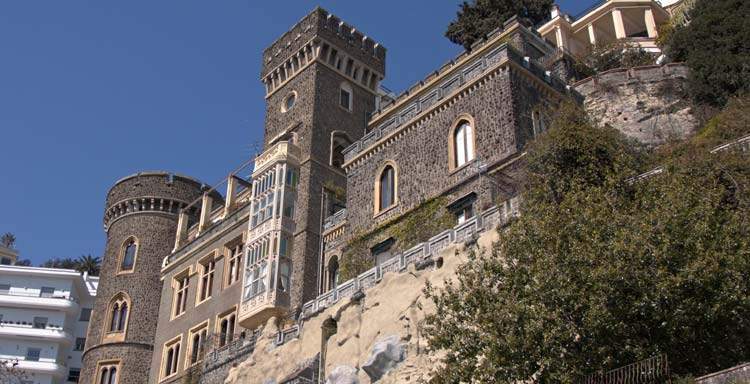On Friday, Oct. 21, theFrench Institute of Naples Grenoble will present the premiere of the documentary The Dream of Lamont Young, focusing on the history, works and mysterious death of Lamont Young, a famous English architect who lived in Naples in the late 19th and early 20th centuries. Produced and directed by Francesco Carignani for Fucina Umanistica Digitale, the film recounts the architect’s life and works through numerous interviews with famous Neapolitan professors, including Alessandro Castagnaro, Fabio Mangone, Alfredo Buccaro, Francesco Barbagallo, and Salvatore Di Liello.
Beginning with his mysterious suicide in the Castle of Villa Ebe, now in a state of ruins, the documentary aims to recount his spectacular projects carried out in Naples in the early twentieth century, with an emphasis on his “pseudo-Victorian” and neo-Gothic style: many unusual buildings for the city’s architecture, including several castles, a Swiss chalet, and the less famous revolving house in Vivara. Especially illustrated are the projects that were never realized, visionary for that time, and that could have changed the face of Naples, such as the first subway project for the city, which was viewed with much distrust at the time. The project consisted of a real urban plan for the city that included inoltra the construction of an archipelago of islands in Posillipo, the Rione Venezia and a part on Bagnoli, the redevelopment of which is still far away today. With extreme foresight, in fact, Young had identified Bagnoli as an ideal point for tourist and cultural development, planning there the terminus of his subway, where bathing stations, large hotels, public parks and a palace for international exhibitions were to be built, which would host works from various countries, to give those Neapolitans who would not be able to travel the opportunity to discover other cultures. So we see how Lamont Young more than a century ago was already paying great attention to issues that are more relevant today than ever before: sustainability, ecology and culture.
But in addition to the works, the documentary also analyzes other aspects of this character, such as his passion for inventions, which saw him author numerous patents, including a flying machine. The work also delves into personal themes of this genius’ life, succeeding exclusively and for the first time in solving some of the mysteries related to this character and especially his death.
Thanks also to the music by Pellegrino Snichelotto, the documentary tells the story of a city that is still strongly international, a Naples that is no more, capable of attracting geniuses and great industrialists from abroad, still representing a lively point of reference for international worldliness. This, then, is the story of the character who could have brought about a great change that would have confirmed Naples among the great European capitals: a change that unfortunately did not take place. His project, in fact, despite arriving after a thousand difficulties to be approved by the City Council, failed by a whisker due to bureaucratic problems. The documentary will also address the fate of Bagnoli, which has instead become one of the world’s largest steel poles. It will also talk about Villa Ebe today, purchased by the City in the 1990s and destroyed in an arson attack in 2000, just months after the residents’ battle not to see it turned into a parking lot. Today the Villa remains in a state of neglect, and finally, thanks to the efforts of the City Council and Vice Mayor Lieto, it appears that an international call for bids may return the Villa to citizens.
“I wanted to introduce this brilliant architect to the general public,” says Francesco Carignani, “and tell the story of his vision of the city, which was so modern even more than a century ago. But I also had two other goals. The first was to help bring attention back to the issue of Bagnoli and Villa Ebe, which is still in a state of ruins; the second was to delve deeply into the personal aspect of this genius: not only to tell his story, but also to tell the story of the man and his dreams. We were thus able to solve the mysteries related especially to the last phase of his life, his death. However, I also wanted to tell the story of an era that no longer exists, a Naples that is still strongly international, and for this reason I immediately thought that the story should also be animated by the music of Pellegrino Snichelotto. This project began years ago, with the creation of Lamont Young’s Facebook page: by having the architect speak directly and basing myself on the writings of Professor Giancarlo Alisio (to whose memory the documentary is dedicated), I began to narrate his buildings in the first person, as if Lamont himself had been the one to tell them. I then illustrated my documentary project to Professor Antonella Di Luggo and Professor Alessandro Castagnaro of the Department of Architecture at Federico II, the first people who believed in this project, and it was thanks to their support that the documentary was able to see the light.”
The documentary was made with the contribution of the Campania Region (Direzione Generale
Government of the Territory, pursuant to Regional Law 19/2019), with the scientific support of the Department of Architecture of the University of Naples Federico II and with the moral patronage of the City of Naples, the National Association of Italian Engineers and Architects (ANIAI Campania) and the Neapolitan Society of National History.
 |
| Coming soon, a documentary on Lamont Young, brilliant architect who invented modern Naples |
Warning: the translation into English of the original Italian article was created using automatic tools. We undertake to review all articles, but we do not guarantee the total absence of inaccuracies in the translation due to the program. You can find the original by clicking on the ITA button. If you find any mistake,please contact us.